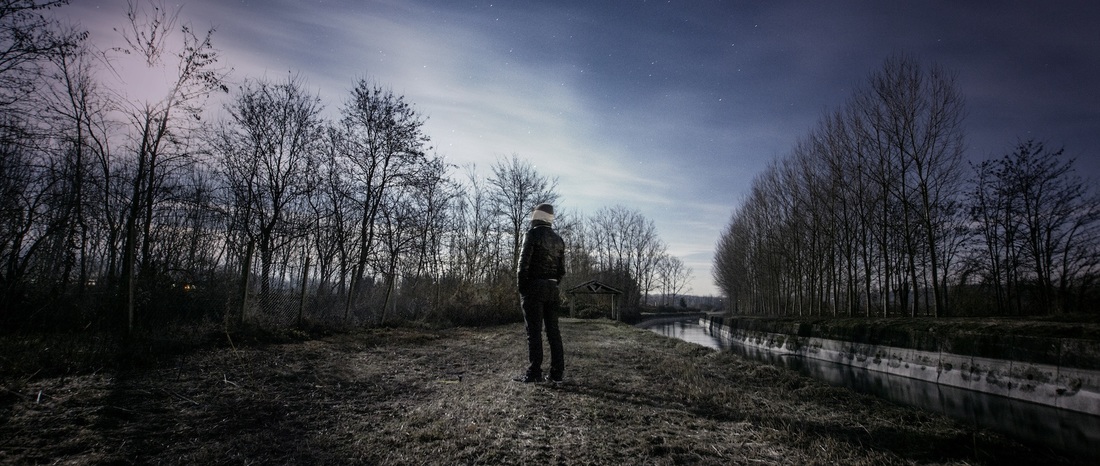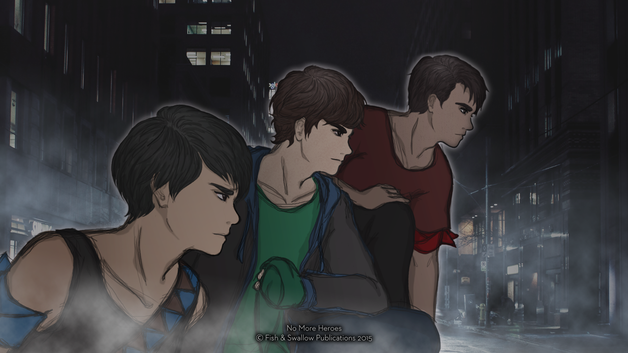Hey, friends! Guess what? It's October, which means we're officially one month closer to National Novel Writing Month 2016 and it's time to start planning! Woo!
Some of you may or may not already know that No More Heroes started off as a pretty straightforward WriMo venture back in 2014. It was my first Nano and I was inspired to participate in part due to my friend Saf of Not Saf for Work – more specifically, I was spurred by my desire to write some more fun, action-oriented long-form fiction, following my experience doing a short, chaptered 'companion' story which was based off a superhero-themed WriMo Saf wrote way back in the day. Prior to No More Heroes I spent a great deal of time writing mostly one-off short stories which were stylistically very different to how No More Heroes ended up being!
For my first NaNo ever, I'm pleased to say I did pretty darn well! I was motivated and full of ideas and ended up hitting the quarter mark less than a week in, smashing the 50K goal in about 20 days, and finishing off the month with more than 62K under my belt. Sure puts the 8K postgrad thesis I took eight months to write into perspective, haha. Due to some of the rad winners' perks for that year I was encouraged to self-publish No More Heroes on CreateSpace, effectively making me the published author that I always wanted to be as a teenager.
However, even though I was brimming with inspiration, I definitely wouldn't have been as onto it as I was if I hadn't been prepared in advance. So for this blog post, I'm going to share three simple but helpful tricks that helped me get through my first (and second) NaNoWriMo/s. I know that planning is often a case of 'different strokes for different folks', but for those of you that do benefit from a little structure like myself (even though we might like to see ourselves as being improvisational and spontaneous), this list might be helpful for you! So without further ado...
Some of you may or may not already know that No More Heroes started off as a pretty straightforward WriMo venture back in 2014. It was my first Nano and I was inspired to participate in part due to my friend Saf of Not Saf for Work – more specifically, I was spurred by my desire to write some more fun, action-oriented long-form fiction, following my experience doing a short, chaptered 'companion' story which was based off a superhero-themed WriMo Saf wrote way back in the day. Prior to No More Heroes I spent a great deal of time writing mostly one-off short stories which were stylistically very different to how No More Heroes ended up being!
For my first NaNo ever, I'm pleased to say I did pretty darn well! I was motivated and full of ideas and ended up hitting the quarter mark less than a week in, smashing the 50K goal in about 20 days, and finishing off the month with more than 62K under my belt. Sure puts the 8K postgrad thesis I took eight months to write into perspective, haha. Due to some of the rad winners' perks for that year I was encouraged to self-publish No More Heroes on CreateSpace, effectively making me the published author that I always wanted to be as a teenager.
However, even though I was brimming with inspiration, I definitely wouldn't have been as onto it as I was if I hadn't been prepared in advance. So for this blog post, I'm going to share three simple but helpful tricks that helped me get through my first (and second) NaNoWriMo/s. I know that planning is often a case of 'different strokes for different folks', but for those of you that do benefit from a little structure like myself (even though we might like to see ourselves as being improvisational and spontaneous), this list might be helpful for you! So without further ado...
| |
1. Get To Know Your Characters
I wrote a blog post a while ago called Three Quick Ways to Establish and Flesh Out Your Characters, which was – you guessed it – a little list of my favourite three tricks on character creation and development. If you haven't checked it out, give it a read! You might find something useful to you. This might seem like a really basic and obvious first point, but it's worth reiterating, especially when it comes to writing your character/s into situations of conflict, or scenarios where their flaws or vulnerabilities might make themselves apparent.
Beyond just knowing things like their primary characteristics, friends/enemies, likes/dislikes or fears, ask yourself questions like: what fundamental 'rules' does this character follow (ie. moral code)? How does this character react to stress? How do they behave when faced with a task or situation they might not be equipped to or want to handle? Once you have a good grasp on a character's behaviour patterns, it becomes a lot easier to both know what obstacles to throw them, as well as understand how they might (or might not) overcome them.
Beyond just knowing things like their primary characteristics, friends/enemies, likes/dislikes or fears, ask yourself questions like: what fundamental 'rules' does this character follow (ie. moral code)? How does this character react to stress? How do they behave when faced with a task or situation they might not be equipped to or want to handle? Once you have a good grasp on a character's behaviour patterns, it becomes a lot easier to both know what obstacles to throw them, as well as understand how they might (or might not) overcome them.
| |
2. Understand the Rules of your World
If you've ever been a DnD Dungeon Master or participated in a DnD campaign, you'll probably be familiar with this process. This will be a different experience for everyone. No More Heroes, an urban fantasy, was initially pretty close to the 'real world' as we know it, at least when it came to setting. As I continued to develop the lore behind my main mechanics though, the setting (and thus the rules) of the world shifted further and further into unknown territory, resulting in the substantially more unique universe that I ended up with in the final novel. I wrote a lot of notes on the "science" behind Abilities during my planning phase – science which I never really got into elucidating during the course of book, but which I'm hoping to be able to explore more in future stories in the Vigilante universe.
By the way, by 'rules' I mean questions like 'what kind of influence does the setting have over your characters' and 'what kind of influence do your characters wield over their environment'. Is the core conflict of your story Man vs Man, Man vs Nature, Man vs Self, or something else entirely? I usually default to Man vs Man, but depending on where your novel sits on the reality/fantasy spectrum, you'll have your own particulars to consider in terms of what makes your setting work for your story. By understanding your world and the rules it follows, you can play with the challenges or advantages it presents your characters, and what kind of physical, mental or societal limitations exist.
By the way, by 'rules' I mean questions like 'what kind of influence does the setting have over your characters' and 'what kind of influence do your characters wield over their environment'. Is the core conflict of your story Man vs Man, Man vs Nature, Man vs Self, or something else entirely? I usually default to Man vs Man, but depending on where your novel sits on the reality/fantasy spectrum, you'll have your own particulars to consider in terms of what makes your setting work for your story. By understanding your world and the rules it follows, you can play with the challenges or advantages it presents your characters, and what kind of physical, mental or societal limitations exist.
| |
3. Find Your Beats/The Three Act Narrative Structure
I'm going to admit up front that I have a kind of love-hate relationship with the ol' Three Act Narrative Structure. On the one hand, I hate the idea that all stories must follow a three act structure to be "good", because that's just not true. On the other hand, I really enjoy the substance that planning to the three act structure gives my long-form work, and knowing all my major turning points in advance really helps me pace out my story before November even starts. Gah!
But for real, the three act structure has been incredibly helpful for me. Being able to have a reference for which beats I should have where has allowed me to learn how to space out the events of my story and how to arrange them to work up to the pivotal climax of my novel. I have a specific fifteen-beat outline that I follow within the three act structure, which is a hybrid of an elaboration on the three act structure with a version of the Hero's Journey. After I've figured out what's happening and when, I separate my outline into chapters, which makes my workload a lot easier to parse. Also, it's really fun coming up with chapter titles.
But for real, the three act structure has been incredibly helpful for me. Being able to have a reference for which beats I should have where has allowed me to learn how to space out the events of my story and how to arrange them to work up to the pivotal climax of my novel. I have a specific fifteen-beat outline that I follow within the three act structure, which is a hybrid of an elaboration on the three act structure with a version of the Hero's Journey. After I've figured out what's happening and when, I separate my outline into chapters, which makes my workload a lot easier to parse. Also, it's really fun coming up with chapter titles.
| |
And there they are. To be honest, these are all pretty simple points – not very groundbreaking or revolutionary at all! But all these plus ample advance planning time really do make a world of difference when it comes to a venture like NaNoWriMo. And of course, your story, your characters and your world rules may well change during the course of your writing – they certainly did for me, with some big ol' plot revelations and new ideas only dawning on me halfway during the month. But having a structure you can work off and pre-establishing even some of the above can really make for a much smoother ride all around, especially when time is not on your side.
If you have your own methods you like to employ when it comes to story planning, leave a comment and let me know! I'd love to hear about it. And as always, if you'd like to see the fruits of my labour, you can get your own physical or digital edition of No More Heroes from Amazon or Kobo. In the meantime, all the best to all your NaNo'ers, old-hands and novices alike, and I hope you all have a good October and a productive NaNoWriMo to come! : )
If you have your own methods you like to employ when it comes to story planning, leave a comment and let me know! I'd love to hear about it. And as always, if you'd like to see the fruits of my labour, you can get your own physical or digital edition of No More Heroes from Amazon or Kobo. In the meantime, all the best to all your NaNo'ers, old-hands and novices alike, and I hope you all have a good October and a productive NaNoWriMo to come! : )





 RSS Feed
RSS Feed